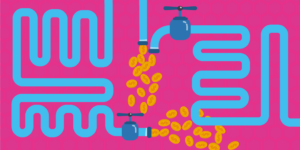A statement of cash flows is a report that summarizes and calculates your cash flow — the movement of liquid assets into and out of your company. Along with your income statement and balance sheet, it is one of the most fundamental financial reports you can create for your business. The Securities and Exchange Commission (SEC) requires publicly traded companies to release periodic cash flow statements. Investors have a right to these documents to make informed investment decisions and keep these businesses accountable. Cash flow statements are not a requirement for private businesses. However, they can be an invaluable tool for monitoring your company’s short-term financial health and establishing your creditworthiness to potential lenders.
Cash Flow Statements Help You Monitor Your Firm’s Health
Your cash flow statement is a snapshot of your company’s ongoing financial health. Net cash flow is crucial in assessing a company’s financial health as it shows the overall cash generated or spent during a specific reporting period. It contains vital information for:
- You and your financial officers — To manage your firm’s operating expenses, you must ensure that the money coming in is at least equal to the money going out. Your cash flow statement measures how successfully you are generating cash to meet your obligations and allows you to predict future cash flows.
- Investors — Anyone who finances a business will want to know how their money is being spent. A cash flow statement provides transparency and accountability, guarding against waste and fraud.
- Creditors — When you apply for a business loan, your lender will want to make sure your operations are on a solid footing. If you have the liquidity to fund your current obligations, they may be willing to extend additional credit.
What Should Be Included in a Cash Flow Statement?
A cash flow statement divides your data into three fiscal categories: operating, investing, and financing activities. Cash and cash equivalents play a crucial role in this statement, representing liquid assets on a company’s balance sheet. Each represents a different way that money can flow in and out of your business. Closely examine each of these three sections and keep an eye on the totals in the bottom line. That way, you can make adjustments if your cash flow picture is not as clear as you’d like it to be.
Operating Activities
Operating activities are the income and expenses related to regular business operations. Changes in accounts receivable impact cash flows by adjusting net income to reflect the actual cash position, particularly when using the indirect cash flow method. Your gross sales receipts will be listed here, as well as expenditures like:
- Raw materials for manufacturing
- Advertising
- Production costs
- Delivery and shipping
- Utilities
- Mortgage or rent
- Interest
- Taxes
- Employee salaries and wages
- Inventory
Investing Activities
Investing activities are transactions that involve an upfront payout of cash or borrowed funds with the expectation of a larger future return. The cash generated from investing activities is crucial as it reveals the amounts of cash generated and spent over time, helping to analyze a business’s liquidity and long-term solvency. This often consists of the purchasing or sale of assets. The asset involved may be necessary for operations, such as equipment or office space, but such transactions are not usually part of businesses’ day-to-day procedures. Instead, a cash flow statement will include income or expenses related to these items in the investments section. Investing activity includes transactions related to:
- Buildings and land. (Unless you are in the business of real estate, in which case these may fall under operating activity.)
- Equipment.
- Marketable securities like stocks, bonds, and certificates of deposit.
- Mergers and acquisitions.
Financing Activities
Financing activities are the inflows and outflows of cash used to fund your business. These transactions include cash inflows from various sources such as bank loans, issuing shares, and contributions from investors. These transactions include:
- Bank loans and interest
- Issuing or buying back company shares
- Contributions from investors
- Dividends paid to shareholders
Non-Cash Disclosures
Non-cash activities should also be disclosed as a footnote or addendum to the cash flow statement if they are not included in the main sections. Cash is not flowing into or out of your business with these activities, but they can substantially impact current and future profits. It is important to differentiate these from cash payments, as the direct method of cash flow statements relies on actual cash payments and receipts to provide a clear picture of cash inflows and outflows. Examples of non-cash disclosures include:
- Asset exchanges
- Stock conversion
- Issuing stock to pay off a debt
- Issuing stock as reimbursement for services received
- Using stocks or a note to buy an asset
Negative or Positive Cash Flow Calculations
All of the activities listed on a cash flow statement are used to calculate your company’s overall cash flow during that period. Expenditures are subtracted from income, and the difference is displayed on the bottom line of the statement. A negative number indicates that the cash going out has exceeded the cash coming in. Negative cash flow can indicate potential financial issues, but it might also result from strategic business decisions aimed at expansion or growth. Conversely, A positive number means that there has been more money flowing in than has flowed out. Cash flow statements are a snapshot in time, meaning they do not always provide the entire picture of a company’s financial stability. For example:
- A large capital expenditure could impact the bottom line one month, with the expectation that it will boost income in the future.
- A floundering business might take out a loan that would temporarily boost its cash flow numbers. If the underlying problems are not addressed, this influx of cash will not help the company in the long term.
It is essential to look at cash flow statement trends over time rather than in isolation. The trends from one statement to the next will give you the best information about your company’s financial situation on the whole.
Stabilize Income with the Finance Logix
If your company’s cash flow fluctuates, there may be times when it’s challenging to meet your obligations. A new financing service from Finance Logix could be just what you need to maintain smooth-running operations. Use Finance Logix to access supplementary income when you need it during your leanest months, knowing your peak season revenue will more than cover the payback. Even if you have subprime credit, you can qualify with:
- At least $10,000 in sales per month.
- Operational history of six months or more.
- A business bank account that has an average daily balance of $1,000 or higher.
- No more than three negative days in a month.
Our automated underwriting process makes the application process fast and easy. Call (855) 943-5363 today to determine if the Finance Logix financing makes sense for your business.





















